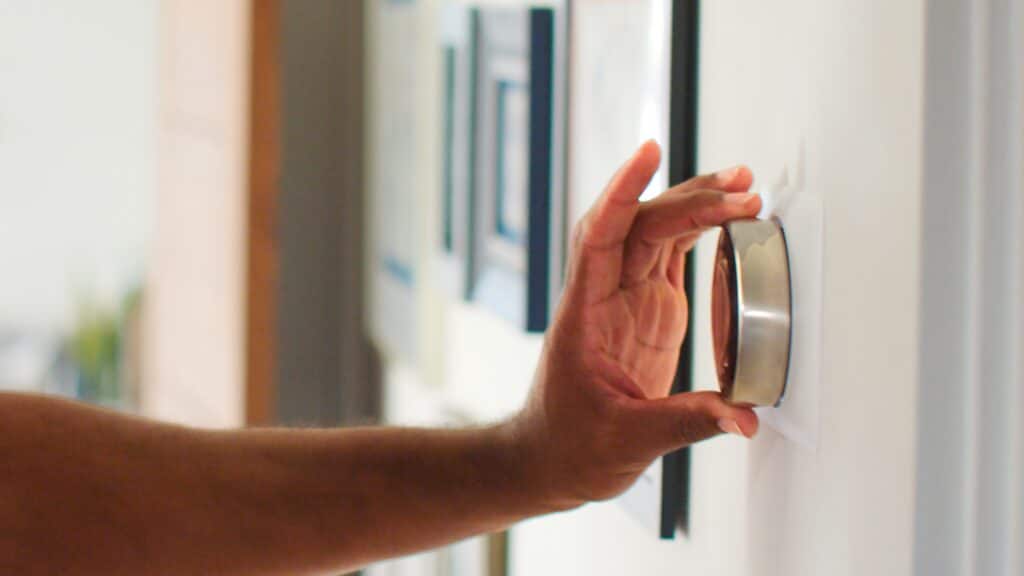
How to Spot a Thermostat Sensor Problem
Experiencing a thermostat sensor problem in your home can be both frustrating and puzzling. This issue, often unnoticed at first, can lead to discomfort and inefficiency in your heating and cooling system. Residents in Fort Worth, TX, and surrounding areas like Argyle and Grapevine, TX, are familiar with the importance of a well-functioning HVAC system. Identifying the early signs of a thermostat sensor problem is crucial for maintaining a comfortable home environment.
Temperature inconsistencies throughout your home are a telltale sign of a thermostat sensor problem. You might notice that some rooms are too hot while others are too cold, despite what your thermostat setting indicates. This can be particularly noticeable in areas with varied climate conditions, such as Argyle, where temperature demands on your HVAC system can vary greatly throughout the year.
Another common symptom is short cycling, where your HVAC system turns on and off more frequently than it should. This not only affects your comfort but can also lead to increased wear and tear on your system. Homeowners in Grapevine, TX, experiencing this issue should take it as a clear indicator that something might be amiss with their thermostat sensor.
Understanding when to call an expert is essential. If you’re encountering these issues or other signs like incorrect temperature readings or your HVAC system not responding to changes in settings, it’s time to seek professional help. An expert can accurately diagnose a thermostat sensor problem, ensuring your home in Fort Worth, TX, returns to its optimal comfort level. Recognizing these warning signs early can save you from more significant issues down the line.
Understanding Thermostat Sensor Problems
Understanding the nuances of a thermostat sensor problem is key to ensuring your home maintains its comfort and efficiency. When the sensor fails to accurately gauge the indoor temperature, it sends incorrect information to your HVAC system. This miscommunication can result in your heating or cooling system working overtime or not enough, leading to discomfort and potential system strain. Recognizing these signs early allows for timely intervention, preventing further complications.
A thermostat sensor problem might also manifest through erratic HVAC behavior, such as unexpected system shutdowns or the system running longer than necessary. This irregular operation can significantly impact your home’s energy consumption, leading to an uncomfortable living environment. In cities like Argyle, where weather conditions can change swiftly, a well-functioning thermostat is crucial for adapting to sudden temperature shifts.
Residents of Grapevine, TX, might observe their HVAC system’s failure to start as another symptom of a thermostat sensor issue. If your system does not activate or responds sluggishly to changes in settings, the sensor could be at fault. It’s essential to address these issues promptly to restore your system’s functionality and ensure your home’s comfort.
When faced with these challenges, contacting a professional is the most effective course of action. Experts in HVAC systems can provide a comprehensive assessment, pinpointing whether a thermostat sensor problem is the root cause of your discomfort. With their help, you can quickly return your home in Fort Worth, TX, to its ideal comfort level, ensuring your system operates efficiently and reliably.

Signs of a Thermostat Sensor Problem in Your Home
A noticeable delay in your HVAC system’s response to thermostat adjustments can be a clear indicator of a thermostat sensor problem. This lag in reaction time disrupts your home’s ability to maintain a consistent temperature. Residents in Argyle might find this particularly troubling, as their comfort relies on swift adjustments to sudden weather changes. Promptly recognizing and addressing this issue ensures your living space remains pleasant.
Another sign of a thermostat sensor problem is when your HVAC system fails to reach the set temperature. You may observe that despite setting a specific temperature, the actual room temperature falls short or exceeds this value. This inconsistency can lead to an uncomfortable home environment, especially in areas like Grapevine, TX, where temperature precision is key to indoor comfort. Such discrepancies suggest it’s time to examine your thermostat’s functionality.
Frequent system resets can also point towards a malfunctioning thermostat sensor. If you find yourself constantly having to reset your thermostat to get your HVAC system to operate correctly, it’s a signal something isn’t right. This continuous need for resets not only hampers your comfort but could also indicate deeper issues within your system. Addressing this early prevents further complications and maintains your system’s efficiency.
Lastly, unusual noises coming from your HVAC system when making temperature adjustments can signify a thermostat sensor problem. These sounds could range from clicking to buzzing, indicating that the thermostat is struggling to communicate with the HVAC system. Such auditory cues should not be ignored, as they offer a clear sign that your thermostat may require professional attention. Keeping an ear out for these noises can help maintain the optimal performance of your home’s heating and cooling system.
The Impact of Temperature Inconsistencies
Temperature inconsistencies in your home can significantly impact your comfort, often stemming from a thermostat sensor problem. When your living space doesn’t seem to match the settings on your thermostat, it’s a clear sign that the sensor might not be accurately reading the indoor temperature. This can lead to some areas being too warm while others are too cool, disrupting the overall comfort of your home. Residents in Argyle, facing varied temperatures, might find this particularly bothersome, highlighting the need for a well-functioning thermostat.
In Grapevine, TX, where precision in temperature control is essential for comfort, noticing your HVAC system’s inability to maintain a consistent temperature could indicate a thermostat sensor issue. If your system frequently overshoots or fails to reach the desired temperature, it’s crucial to address this inconsistency. Such fluctuations not only affect your comfort but can also strain your HVAC system, leading to potential long-term issues. Promptly identifying and rectifying these signs can restore your home’s comfort and system efficiency.
Another symptom of a thermostat sensor problem is when adjustments to the thermostat don’t seem to result in the expected changes in your home’s temperature. This delay in response can be particularly frustrating, as it prevents your HVAC system from effectively managing your indoor climate. It’s essential to recognize this sign early, as it can indicate that the thermostat sensor is not communicating correctly with your HVAC system, affecting its ability to heat or cool your home efficiently.
Lastly, if your HVAC system starts behaving unpredictably, such as turning on and off at odd times or running for longer than necessary, it might be due to a faulty thermostat sensor. These behaviors can lead to unnecessary energy use and discomfort, signaling the need for a professional evaluation. By staying attentive to these signs, homeowners can ensure their HVAC system remains reliable and efficient, maintaining the ideal comfort level in their homes.
Troubleshooting Common Thermostat Issues
Troubleshooting common thermostat issues begins with a simple observation. If your home in Argyle feels uncomfortable despite your efforts to adjust the thermostat, it might be time to investigate. A thermostat sensor problem could be the culprit, affecting your HVAC system’s ability to accurately read and respond to your home’s temperature needs. This misalignment can lead to discomfort and inefficiency, signaling the need for a closer look.
In Grapevine, TX, homeowners might notice their thermostat’s display showing incorrect temperatures or failing to change when adjustments are made. This is a clear indication of a thermostat sensor issue. When the display does not reflect actual room temperatures or ignores input, it disrupts the HVAC system’s operation. Such discrepancies require prompt attention to ensure your home remains comfortable and your system functions efficiently.
Another step in troubleshooting involves checking for any error messages or blinking lights on your thermostat. These signals often point to specific problems, including sensor issues that need addressing. By staying alert to these visual cues, you can identify issues early, preventing further system disruption. It’s a proactive approach to maintaining your HVAC’s reliability and your home’s comfort.
Lastly, a simple reset might sometimes resolve minor thermostat glitches. However, if problems persist after a reset, it likely indicates a more significant thermostat sensor problem. In such cases, professional intervention becomes necessary to accurately diagnose and fix the issue. Experts can ensure your thermostat accurately communicates with your HVAC system, restoring optimal performance and comfort to your home.
How Short Cycling Indicates a Sensor Problem
Short cycling, a common symptom of a thermostat sensor problem, disrupts the efficiency of your HVAC system. When your system frequently turns off and on in short bursts, it’s a clear indication that the thermostat sensor may not be accurately gauging the indoor temperature. This erratic behavior can cause significant wear and tear on your system, leading to premature breakdowns. Homeowners in Argyle should be particularly vigilant, as fluctuating temperatures can exacerbate this issue.
In Grapevine, TX, residents experiencing short cycling should consider the health of their thermostat sensor. Short cycling not only impacts the comfort of your home but also increases energy usage, as the system struggles to maintain a consistent temperature. If your HVAC system cannot complete its normal heating or cooling cycle, it’s a sign that the sensor is failing to communicate effectively with the rest of the system. Addressing this issue promptly can restore system efficiency and home comfort.
The thermostat sensor plays a crucial role in detecting the ambient temperature of your home, guiding your HVAC system to operate accordingly. When this sensor is malfunctioning, it fails to send accurate temperature readings, leading to short cycling. This can be particularly troubling during extreme weather conditions, where maintaining a stable indoor temperature is essential. A faulty sensor can leave residents feeling too hot or too cold, despite what the thermostat setting indicates.
To mitigate the effects of short cycling and other symptoms of a thermostat sensor problem, professional intervention is often necessary. Experts can diagnose and resolve underlying issues with the sensor, ensuring that your HVAC system returns to its optimal operating condition. For homeowners in Fort Worth, TX, seeking professional help can mean the difference between an inefficient system and one that efficiently manages the indoor climate, keeping your home comfortable year-round.

When to Call a Professional for Thermostat Issues
After attempting the DIY fixes for a thermostat sensor problem, if your home’s temperature issues persist, it’s time to consider professional help. Experts in HVAC systems can offer a more thorough diagnosis than most homeowners can achieve on their own. They have the tools and knowledge to pinpoint whether the thermostat sensor is the root of your discomfort. Calling in a professional ensures that any underlying issues are addressed promptly and efficiently, restoring your home’s comfort.
In Argyle, if you’ve cleaned your thermostat, checked its location, recalibrated it, and replaced the batteries, yet problems remain, an expert’s intervention is necessary. Professionals can assess the thermostat’s functionality and its communication with your HVAC system. This step is crucial, as an improperly functioning thermostat can lead to significant inefficiencies in your heating and cooling system, affecting your home’s overall comfort.
Residents of Grapevine, TX, facing erratic HVAC behavior or consistent temperature inaccuracies should also seek professional assistance. A thermostat sensor problem can be complex, and without the right expertise, you might miss subtle signs of malfunction. An HVAC specialist can also provide valuable advice on preventing future issues, ensuring your system remains reliable over time.
Ultimately, while some thermostat issues can be resolved with simple troubleshooting, others require a deeper technical understanding. By recognizing when to call in a professional, homeowners can save time and avoid the frustration of unresolved issues. An expert in thermostat sensor problems can ensure your system operates smoothly, keeping your home comfortable regardless of the season.
Preventing Future Thermostat Sensor Problems
To prevent future thermostat sensor problems, regular maintenance is key. This includes scheduling annual check-ups with a professional HVAC service. During these visits, experts can inspect your thermostat’s sensor and ensure it’s functioning correctly. Such preventive measures can save homeowners in Argyle from unexpected discomfort and system inefficiencies.
Another effective strategy involves paying attention to the thermostat’s environment. Ensure it’s placed away from direct sunlight, drafts, and other heat sources. This simple adjustment helps maintain accurate temperature readings, crucial for homes in Grapevine, TX, where climate control is essential for comfort throughout the year.
Educating yourself on basic thermostat functions can also be beneficial. Knowing how to properly set and adjust your thermostat can prevent unnecessary strain on the sensor. Residents can consult their HVAC provider for tips on optimizing thermostat settings to suit their specific needs, enhancing the system’s longevity.
Lastly, embracing technological advancements in thermostats can offer a long-term solution. Upgrading to a smart thermostat provides more accurate temperature control and monitoring, reducing the likelihood of sensor problems. For homeowners in Fort Worth, TX, this investment can lead to improved system performance and energy efficiency, ensuring a comfortable home environment year-round.
Frequently Asked Questions
What are signs of a thermostat sensor problem?
Signs of a thermostat sensor problem often include inconsistent temperatures throughout your home. You might notice your heating or cooling system short cycles, turning off and on more frequently than normal. Another indicator is when the actual room temperature doesn’t match the thermostat setting, suggesting a sensor issue. If you experience these symptoms, it’s wise to contact a professional to check your system.
How can I test my thermostat sensor?
To check if your thermostat sensor has a problem, start by comparing the setting to the actual room temperature. If there’s a noticeable difference, the sensor might not be working correctly. You can also gently clean the sensor, removing any dust or debris that could affect its performance. If issues persist after cleaning, it’s best to contact a professional for a thorough inspection and possible repair.
What causes a thermostat sensor problem?
Several factors can lead to a thermostat sensor problem. Dust and debris accumulation is a common culprit, interfering with the sensor’s ability to accurately read temperatures. Wear and tear over time can also affect its performance, especially in older systems. Incorrect installation or placement can cause issues, as the sensor might be in a spot where it can’t measure the room’s temperature properly. Lastly, electrical problems within the home’s HVAC system can disrupt the sensor’s function, requiring professional attention.
Can I fix a thermostat sensor problem myself?
Fixing a thermostat sensor problem yourself can be challenging without the right tools and knowledge. Some issues, like cleaning dust or repositioning, are simple fixes you can do. However, more complex problems require professional expertise to ensure your system functions correctly. It’s best to consult with an expert if you’re unsure, to avoid further damage to your HVAC system.
How often should I check for a thermostat sensor problem?
It’s wise to check for a thermostat sensor problem at least once a year. This routine can ensure your system runs smoothly and efficiently. If you notice any irregularities, like temperature inconsistencies, it might be time for a closer inspection. Always remember, calling a professional for a detailed check-up can prevent bigger issues down the line.


